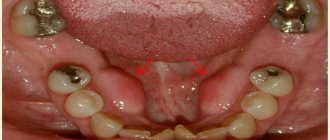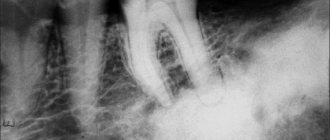Osteosarcoma is a malignant tumor that grows from bone cells. This is a very rare type of neoplasm, most types of which are characterized by rapid growth and an aggressive course. Osteosarcoma should not be confused with bone metastases, since they are the result of the spread of neoplasms that primarily developed in other organs.
The main feature of osteosarcoma is that its cells are capable of producing bone tissue, but it is immature. Basic bone substance cannot be formed from it, and calcification does not occur in it. This feature distinguishes osteosarcomas from other malignant and benign bone tumors.
- Causes
- Symptoms
- Diagnostics
- Treatment
- Complications
- Prognosis for osteosarcomas
- Prevention
As for epidemiology, the incidence rate is 10-26 cases per 1 million people per year. The male population suffers more often. The male to female ratio is 1.36/1. There are two peaks in the rise in incidence. The first occurs at the age of 10-14 years, and the second at the age over 40 years. Very rarely, neoplasms are registered in children under 5 years of age.
Osteosarcoma can affect absolutely any bone, but most often the tumor is diagnosed in the long tubular bones of the extremities in the areas of so-called “growth plasticity” - the metaphysis.
Osteosarcoma of flat bones is more often observed in people of the older age group. In this case, the bones of the lower jaw and pelvic bones are mainly affected. The vertebrae may also be affected.
Root causes of disease progression
The causes of osteosarcoma of bone are unknown. After conducting a number of studies, factors were identified that may be involved in the development of the disease. Among them are:
- chemotherapy carried out during the development of another disease;
- Radiation therapy is a side effect;
- injuries of tubular bones;
- fractures (pathological factor);
- osteomyelitis that has become chronic;
- weakened immune system (presence of a large number of bacterial and infectious agents in the body).
Other causes of osteosarcoma include genetic predisposition, harm associated with professional activities, and osteitis deformans.
Kinds
There are several types of classification of osteosarcoma of bone. The first division is based on histological structure:
- high level of differentiation;
- average;
- short;
- morphologically not determined.
There is also another classification of osteosarcoma of bone, proposed by the World Health Organization:
- osteogenic sarcoma, belonging to the ordinary type;
- osteoblastic appearance;
- chondroblastic type;
- sarcoma belonging to the fibroblastic type;
- fibrous-histacytoma-like form;
- osteoblastoma type;
- epithelial single-cell type;
- telangiectatic osteosarcoma.
The classification can be supplemented with the following forms: osteosarcoma, consisting of large cells, small cells, central osteogenic, osteogenic Ewing sarcoma.
Particular types of osteosarcoma
Specific types of osteosarcoma include:
- telangiectatic;
- osteosarcoma of the femur;
- sarcoma of the pelvic bones.
Telangiectatic osteosarcoma of the bone is a rare form of the disease (5% of the total). Expression: The cystoid tissue fills with blood. At risk are male patients under 20 years of age. The affected area will be hot, swollen, and painful.
Osteosarcoma of the femur is a rare disease with aggressive growth parameters. In the area of secondary damage, the lung tissue and liver manifests itself in the form of pain in the thigh area (dull pain), accompanied by an increase in body temperature to 38-39˚C and higher. This type of disease is characterized by pain that intensifies at night, and pathological cells quickly spread in the bloodstream.
Osteosarcoma of the hip joint occurs in patients in rare cases, affects the pelvic bones of the thigh, originates from cartilage and bone structures, and under the blood flow, pathological cells penetrate into distant organs. The disease develops quickly, and young men are at risk. It is expressed by pain in the pelvis, buttocks, increased body temperature, the skin changes color, becomes bluish or purple.
Symptoms and signs of the disease
Osteosarcoma of the bone appears suddenly as a result of the above diseases or as a manifestation of a genetically determined process. The disease develops quickly with the manifestation of secondary symptoms.
The main symptoms of osteosarcoma: at the initial stage of development, it is difficult to determine the specific location of pain. Painful attacks are especially common at night and with heavy loads on the limbs. When symptoms appear, osteosarcoma is confused with rheumatic myalgia, the difference being the absence of fluid collection in the joints.
Over time, the symptoms of osteosarcoma become pronounced, the tumor will grow, affecting the surrounding tissue. This will lead to increased pain. Over time, these symptoms are accompanied by swelling of the bone, possible fractures and the formation of false joints.
Bone biopsy
The final diagnosis will be established only by microscopy of a piece of tumor tissue taken during a biopsy. This is the most difficult, but mandatory diagnostic measure. A biopsy is performed in different ways, preference is given to methods that are minimally traumatic and promote the dispersion of malignant cells in the surrounding tissues.
The clinic performs a biopsy under CT (computed tomography) control. This is an accurate and least traumatic method.
When sarcoma spreads to surrounding structures, a soft tissue component is taken for examination without a biopsy of the bone itself, which minimally injures and protects against a possible pathological fracture against the background of a violation of the structural integrity of the bone. A piece of tumor tissue must be left “for the future” so that when new genetic markers appear, sensitivity to effective drugs can be determined.
Of course, the diagnostic menu includes chest x-ray and abdominal ultrasound to detect asymptomatic metastases, blood tests and isotope scans of the skeleton - osteoscintigraphy.
Manifestation of osteosarcoma in children
Osteosarcoma in children does not manifest itself in the initial stages; the presence of the disease can be determined in the last stages of development. Adolescents are at risk (boys more often than girls); this is a common type of disease. The affected area (80%) is the femur on the side of the knee or the tibia closer to the knee (osteosarcoma of the tibia).
The main symptoms of osteosarcoma in children include:
- pain;
- lameness;
- swelling of the bone.
During osteosarcoma in children, the immune system weakens, and the muscles of the arms and legs are depleted. After the examination, a course of treatment is selected; for this, the doctor may prescribe an MRI or biopsy.
Features of the clinic
Since the tumor actively infiltrates neighboring organs, it manifests itself very acutely. When the vessels are compressed, intensive venous vascularization is caused, damage to the nerve trunks leads to conductive pain along their course, and when the trachea is captured by the process, respiratory disorders are initiated.
According to the generally accepted classification, the symptoms of osteosarcoma of the jaw depend on:
- stages of process development (increasing from I to IV);
- form of tumor (osteolytic, osteoplastic or mixed);
- degree of malignancy (high, low or medium);
- nature of the course (localized or metastatic).
The location of the tumor also matters (it is either central or peripheral).
The initial moment of pain in osteosarcoma can last for days or years (hence the delay in seeking help from doctors and their powerlessness to help). With mandibular localization, they occur earlier, accompanied by irradiation into closely spaced teeth. Sarcoma usually debuts with aching pain at night.
Subsequently, toothaches increase, gum hyperemia is observed, often accompanied by itching, teeth become loose, and problems arise when closing the jaws while chewing food. The effect of using analgesics disappears.
Indicative is the deformation of the face due to its swelling, accompanied by either an exacerbation of pain sensitivity and significant compaction of the tissues involved, or its loss (in the case of the chin, they speak of Vincent’s syndrome).
Temperature surges in the case of osteosarcoma are also quite typical. If in the initial stages of development its rise occurs rarely or is not observed at all, then as intoxication increases and the body’s defenses weaken, fluctuations appear from low-grade levels that persist for several days to normal ones. When the tumor disintegrates, the numbers reach 40⁰ C, remaining at this level for a considerable time (especially when tissues become infected due to weakened immunity).
Common symptoms that indicate osteosarcoma include progressive weakness with lethargy and sweating, decreased performance, irritability, signs of weak immunity and damage to the lymphatic system (lymphadenitis).
Local signs of central osteosarcoma are signs of involvement of structures of neighboring areas in the process: when moving to the sinuses, this is difficult nasal breathing, bloody discharge from the nose, and when spreading to the orbit - exophthalmos.
With alveolar localization of the tumor, there is weakness of the jaw structures, which are easily damaged during eating, with the appearance of cracks and ulcers on the mucosa as a result of secondary infection. In this case, facial deformation can occur even in the initial phase of the disease.
Later tumor formation manifests itself as periostitis of the jaw, hyperplasia of bone tissue, tooth loss, and speech dysfunction.
Features of osteogenic sarcoma in children are an ultra-fast to explosive rate of growth of the tumor mass (due to the active formation and rapid growth of connective tissue) and frequent recurrence of the disease.
Diagnosis of osteosarcoma
Diagnosis of osteosarcoma in the center of Moscow is carried out by oncology doctors. The first stage of diagnosis is communication with the patient, studying the symptoms, his complaints, and condition. It is important for the doctor to determine whether there is a genetic predisposition, or whether relatives have had or have had cancer.
The second stage is inspection of the lesion site, palpation. At this stage, a specialist can use various tools and use laboratory diagnostics.
Our oncology center uses the following diagnostic methods:
- radiography. Thanks to this technique, it is possible to establish the lesion;
- CT scan. Oncology specialists can perform a computed tomography scan or prescribe an MRI, which can help determine the focus of the secondary lesion;
- puncture trepanobiopsy. Using this procedure, it is possible to understand the nature of the tumor.
Tests are also prescribed, liver tests and other studies are performed.
Treatment
When diagnosing osteosarcoma, it is important to choose the right course of treatment. Treatment depends on a number of factors: the patient’s age, his condition, the development of the disease, which location is affected. The following methods of treatment of osteosarcoma of the femur and other affected areas are practiced in oncology:
- chemotherapy. Goal: reducing the size of the pathological focus, reducing the ability of cells to divide and spread;
- radiotherapy. Goal: destruction of remaining cells. Doctors are doing everything to prevent such relapses from happening again;
- surgical intervention. Goal: remove tissues and organs involved in the process. A last resort when the doctor suggests amputating a limb affected by cancer.
In what cases is chemotherapy necessary for bone sarcoma?
The addition of chemotherapy courses to the surgical procedure before and after the intervention significantly reduced the incidence of disease relapse.
Additional cytostatic therapy is not performed for low-grade osteogenic sarcomas, when the likelihood of relapse is minimal, for small tumors and in the absence of a tumor response to treatment - in case of drug resistance.
Chemotherapy can transform an inoperable process into a removable one, stop the growth of distant metastases, and reduce the clinical manifestations of relapse. The metastatic stage of the disease is an indication for drug antitumor effects.
Studying the removed bone under a microscope allows you to evaluate the effect in detail and plan further treatment. A very good result with the death of 90% of cells is designated as “drug pathomorphosis of III–IV degree”; after the operation, such patients are given 4 more courses according to the same scheme as before the operation. With less pathomorphism, the combination of chemotherapy drugs is changed and treated for a whole year.
In the metastatic stage of osteosarcoma, cyclic polychemotherapy is performed, which does not exclude surgical intervention, since removal of metastases in the lungs affects the patient’s life expectancy.
Formally, a little less than ten cytostatics are active in osteosarcoma; their skillful combination against the background of individually selected accompanying symptomatic therapy, supplemented by timely palliative intervention and optimal removal of metastatic foci can prolong life by months and years with good quality.









